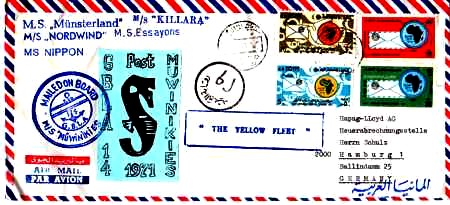
|
Maritime Topics On Stamps :
The Great Bitter Lake Locals !
|
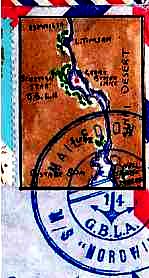
|
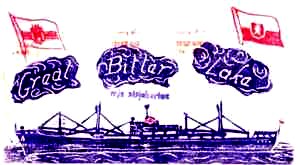
Label at left shows a map of the Suez Canal, a red dot indicating the
anchorages in the Great Bitter Lake. Above, a rubber stamp depicting MS
‘Djakarta’.
|
|
In June of 1967, a convoy of 14 freighters was underway in the Suez Canal,
northbound, when war broke out between Israel and Egypt. The canal was
officially closed and the ships had to anchor in the Great Bitter Lake.
Within three days it became clear that the canal was going to be blockaded
for an indefinite amont of time due to the deliberate sinking of vessels. The
hostilities entered history books as the Six-Day-War. For the ships it meant
almost eight years of forced isolation, imprisoned in the Great Bitter Lake.
|
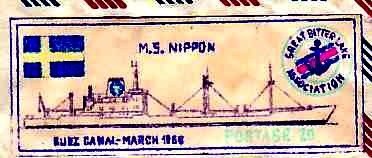
|
Die 14 Schiffe waren:
- 'MS Nordwind', 8.656 GRT, Nordstern Reederei, Germany.
- 'MS Münsterland', 9.365 GRT, Hapag-Lloyd, Germany.
- 'MS Killara', 10.714 GRT, Rederiaktiebolaget Transatlantic, Sweden.
- 'MS Nippon', 10.309 GRT, Svenska Ostasiatiska Kompaniet, Sweden.
- 'MS Essayons' ex 'Sindh', 7.051 GRT, Ruul-Pedersen Reederi, Norway;
(at war’s outbreak MS 'Sindh' was owned by Messageries Maritimes, France.)
- 'MS Agapenor', 7.654 GRT, Blue Funnel Line, England.
- 'MS Melampus', 8.509 GRT, Blue Funnel Line, England.
- 'MS Scottish Star', 10.174 GRT, Blue Star Line, England.
- 'MS Port Invercargill', 10.463 GRT, Port Line, England.
- 'SS African Glen', 6.116 GRT, Farrell Lines, USA.
- 'MS Djakarta', 6.915 GRT, Polish Ocean Lines, Poland,
- 'MS Boleslaw Bierut', 6.674 GRT, Polish Ocean Lines, Poland.
- 'MS Vassil Levsky', 4.975 GRT, Navigation Maritime, Bulgaria.
- 'MS Lednice', 1.462 GRT, Czech Danube Navigation, Czechoslovakia.
A 15th vessel was anchored in Lake Timsah, TT ‘Observer’, USA. Ship and crew
were not part of the Great Bitter Lake Association.
|
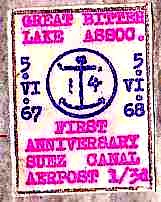
|
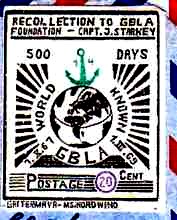
|
|
In October of 1967, all 14 captains and crews got together aboard the British
‘Melampus’ and founded the 'Great Bitter Lakes Association'. Its main
purpose was to promote and cultivate friendships, mutual assistance, and
joint undertakings.
The two locals above commemorate the first anniversary and ‘500 Days GBLA’,
respectively.
|
|
All 14 vessels were provided with ‘Mailed on Board’ rubber stamps of uniform
appearance, showing an anchor with ‘14’, double stripes symbolizing the Suez
Canal, GBLA initials, and the ship’s name.
Later on they identified the individual ship teams, when the vessels were
placed together in groups.
In the background, a label with ships at anchor.
|
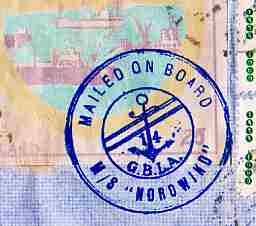
|
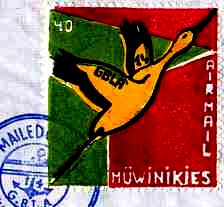
|
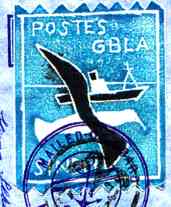
|
The crews kept busy performing maintenance work, mainly. In addition there
were plenty of leisure activities, among them the production of their very
own ‘local postage stamps’ - actually, labels without postal validity. They
were affixed to envelopes and enhanced with ‘Mailed on Board’ stamps. Real
postage had to be added, either Egyptian stamps or meters. Denominations such
as ‘pennies’ and ‘cents’, above, shown on some labels, were purely
decorative. Yet, some covers are known to have reached their recipients
‘franked’ with the locals alone.
Some labels are representing eagles, seagulls, and imaginary birds. They are
symbolizing the desire for freedom and escape, both unattainable, as
inferred by the surrounding walls on the left, and the black wing at right.
|
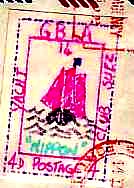
|
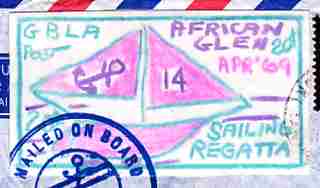
|
|
Among the crews’ leisure activities were frequent meetings dedicated to card
games, movie nights, and athletic competitions. October 1968 saw the ‘Bitter
Lake Olympics’, coinciding with the Olympic Games in Mexico City. Crews from
eight nations competed in 14 disciplines, among them fishing, sailing,
acrobatic jumping, and soccer. Hand crafted medals were the awards. Life
boats became equipped with sailing gear, and a ‘Yacht Club’ was founded -
commemorated with sail-themed labels.
|
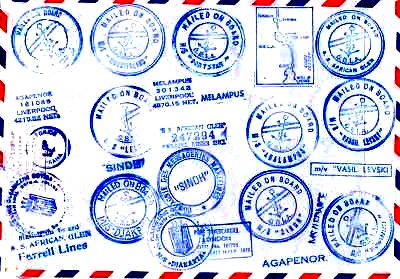
| |
The ships complied with mailing requests from all over the world. To please
collectors, the reverse of covers were serviced with all available stamps of
all vessels. The result can be observed above. On Sundays, everybody used to
meet aboard ‘Nordwind’, brought the rubber stamps along, and worked together
in a small ‘ships cancellation office’.
|
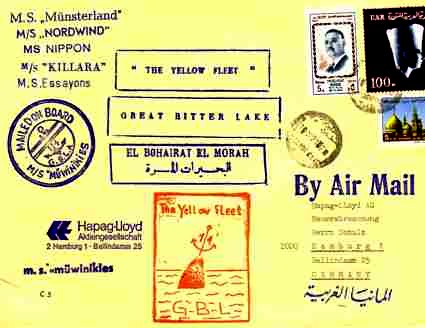
| |
Constant winds blew desert sands upon the vessels. Seen from a distance, the
entire fleet had a yellowish appearance. Hence the nickname 'The Yellow
Fleet', a designation also shown on a number of locals. The buoy depicted
in the red rubber cachet above was actually anchored in the lake by the
ships’ crews, the number ‘14’ again representing the assembled ships.
|
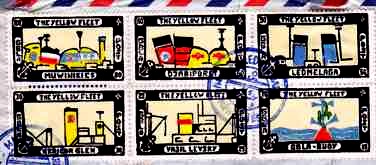
|
Crew reductions became the norm; on HAPAG-Lloyd’s ‘Münsterland’, initially
from 42 to 24, later on to ten. To save even more personnel, in 1969 the
vessels were moored together in several groups. This resulted in new group
rubber stamps as shown above.
Group stamp ‘MS Müwinikies’ got its ‘Mü’ from ‘Münsterland’, ‘wi’ from
‘Nordwind’, ‘ni’ from ‘Nippon’, ‘ki’ from ‘Killara’, and ‘es’ from
‘Essayons’.
‘MS Ledmelaga’ derived from ‘Lednice’, ‘Melampus’, and ‘Agapenor’.
‘MS Portstar’ came from ‘Port Invercargill’ and ‘Scottish Star’.
‘MS Djakbier’ represented ‘Djakarta’ and ‘Boleslaw Bierut’.
Later re-groupings and changes, from 1970 onwards, saw the use of group
stamps ‘Podjabist’, ‘Djabiporst’, ‘Müwiniki’, and ‘Mühwinikindh’.
The labels show the individual groups with their funnel marks. In the top
row, ‘Müwinikies’, ‘Djabiporst’, and ‘Ledmelaga’. In the bottom row, the
individually moored ships ‘African Glen’ and ‘Vassil Levsky’, as well as
the symbolic buoy.
|
|
The circular stamp shown on this cover was created at Christmastime 1971. It
lists the entire 'Yellow Fleet' of the time: The names of the separately
anchored ships are on the top, and underneath are ‘Djabiporst’ (group of 4),
‘Ledmelaga’ (group of 3), and ‘Müwinikies’ (group of 5). The symbolic buoy
is in the center.
|
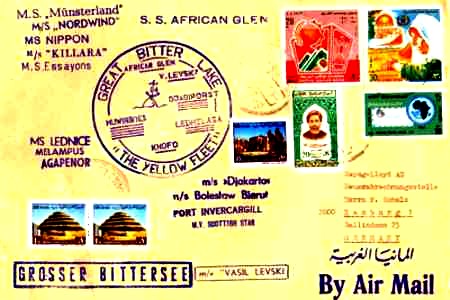
| |
‘KHOFO’ was the name of an Egyptian dredger, at the time
anchored nearby. All the ships names are also represented with individual
handstamps, arranged according to their groupings.
|
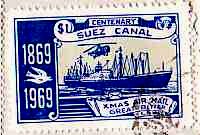
|

|
|
Several labels exist affixed to genuine ships’ covers, but not really part of
the GBLA undertakings. They are strictly commercial, were printed ashore,
brought aboard by ship chandlers, and placed at the disposition of some
sailors. Their professional printing makes them easily detectable. The label
on the right appeared at the time of the ‘G.B.L. Olympics’ in 1968, the one
on the left around Christmas 1969, saluting the Suez Canal Centenary. The
latter design was also printed as a post card. The ship’s picture resembles
the ‘Münsterland’ of Germany.
|
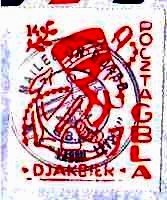
|
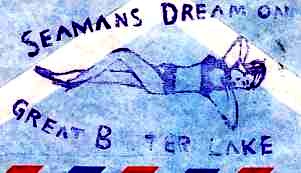
| |
This label shows the ‘Mailed on Board’ stamp of the Bulgarian ‘Vassil
Levsky’, overprinted in red with Nefertiti’s head and the Polish inscription
‘Poczta’ and ‘Djakbier’, evidently a Polish production. The Nefertit design
also exists in green, black, yellow, and dark blue.
On the right a stamp with bathing suit beauty and‘Seaman’s Dream on Great
Bitter Lake’, also reproduced on ‘local stamps’. Believed to be of French
origin, i.e. from ‘MS Sindh’.
|
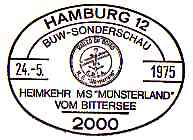
|
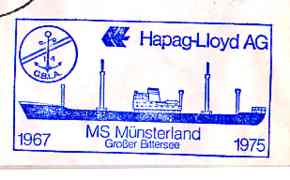
|
|
The spring of 1975 saw the re-opening of the Suez Canal. On May 24, 1975,
both ‘Münsterland’ and ‘Nordwind’ returned to their home port -- the only
two of 14 vessels that were able to sail from the Canal under their own
power. Some 30,000 persons greeted both ships upon arrival in Hamburg. ‘MS
Münsterland’ finally completed a round-trip to Australia that had taken
eight years, three months, and five days!
|
|